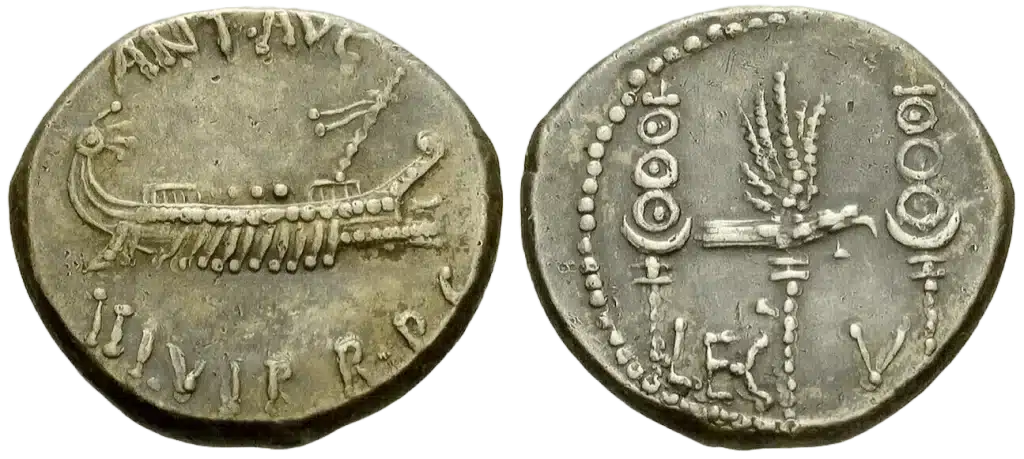If you are interested in ancient Roman coins, you may have come across the so-called “legionary denarii” of Marc Antony. These are silver coins that were issued by Antony in the eastern Mediterranean during the last war of the Roman Republic, from 32 to 31 BC, when he faced his rival Octavian (the future emperor Augustus) in a struggle for power.
The legionary denarii are remarkable for several reasons. First, they are very abundant: it is estimated that between 25 and 35 million pieces were struck, and tens of thousands survive today. They are also very uniform: all of them have the same design, with only minor variations. The obverse shows a galley with a sceptered prow and a forward-slanting mast, symbolizing Antony’s naval power. The reverse shows an eagle between two military standards, symbolizing Antony’s army. The only difference between the coins is the legend on the reverse, which identifies one of the 23 legions that supported Antony, or his cohort of scouts (cohors speculatorum).
The legionary denarii were minted to pay Antony’s soldiers, who numbered about 70,000 infantry and 500 ships. Antony probably struck the coins at his base in Patras, Greece, but it is also possible that they were struck at mobile mints that moved with his legions. The coins weigh about 3.9 grams, which is the normal weight for a denarius coin. However, their silver content is lower than the standard Roman denarius: about 92.2%, compared to 96.84%. This may reflect the scarcity of silver in the East, or Antony’s need to economize.

The legionary denarii also reveal how Antony represented himself and his position in the lead up to his conflict with Octavian. Unlike his previous coinage, which depicted him and his partner Cleopatra, the legionary denarii avoided any reference to Cleopatra and emphasized Antony’s role as a Roman commander. The obverse legend reads ANT AVG III VIR R P C, which means “Antony, augur and one of the Triumvirs for organizing the Republic”. This was a claim to legal legitimacy, as Antony was one of the members of the Second Triumvirate, a political alliance that was formed after Caesar’s assassination in 44 BC. The title of augur also identified Antony as a priest in the Roman state religion.
The legionary denarii were not only a means of payment, but also a way of propaganda. They were intended to show Antony’s loyalty to Rome and his military strength, as well as to boost the morale and loyalty of his soldiers. They were also a challenge to Octavian, who claimed that Antony had become corrupted by Cleopatra and was working for her interests rather than those of Rome. The coins thus expressed Antony’s hope of victory over Octavian and his vision of restoring the Republic.
However, history proved otherwise. In 31 BC, Octavian defeated Antony and Cleopatra at the Battle of Actium, a decisive naval engagement that ended their resistance. The following year, Octavian pursued them to Alexandria, where they both committed suicide rather than surrender. Octavian became the sole ruler of Rome and later took the title of Augustus, founding the Roman Empire.
The legionary denarii are a fascinating testimony of a turbulent period in Roman history. They are also a reminder that money can be used not only as a medium of exchange, but also as a tool of communication and persuasion.



